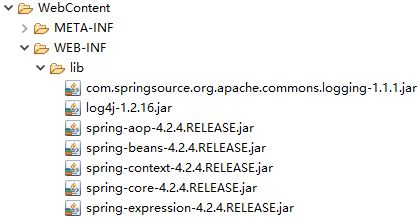1.创建web项目
2.引入jar包

3.日志文件

4.创建实体类
Person
Car
5.创建applicationContext.xml
<beans
xmlns="http://www.springframework.org/schema/beans"
xmlns:xsi="http://www.w3.org/2001/XMLSchema-instance"
xmlns:context="http://www.springframework.org/schema/context"
xsi:schemaLocation="http://www.springframework.org/schema/beans
http://www.springframework.org/schema/beans/spring-beans.xsd
http://www.springframework.org/schema/context
https://www.springframework.org/schema/context/spring-context.xsd">
</beans>
6.配置注解扫描
指定要扫描的包
<context:component-scan base-package="com.spring.pojo"></context:component-scan>
7.在类中使用注解
@Component("person")
@Repository("person")
@Service("person")
@Controller("person")
//<bean name="person" class="com.Spring.pojo.Person"></bean> 相同
8.其他类级别的注释
@Component("person") //适用于所有组件
@Repository("person") //适用于持久层
@Service("person") //适用于service
@Controller("person") //适用于controller
9.指定对象的scope的属性
@Component("person")
@Scope(scopeName="singleton")
10.set方式注入value值
1-在私有的成员变量中注入
@Value("helen") ==@Value(value="helen")
@Value("helen")
private String name;
@Value("18")
private Integer age;
2-在set方法中注入
@Value("tom")
public void setName(String name) {
this.name = name;
}
11.自动装配
@Autowired 进行自动装配,按照对象类型进行自动装配
@Component("car")
public class Car {
@Value("小黄车")
private String name;
@Value("蓝色")
private String color;
public class Person {
@Value("helen")
private String name;
@Value("18")
private Integer age;
@Autowired
private Car car;
自动装配存在的问题:如果一个类型有多个对象,那么可以采取以下的方式
方法一:
使用指定@Qualifier指定具体的对象
@Autowired
@Qualifier("car2")
private Car car;
方式二:
使用@Resource指定具体的对象
@Resource(name="car1") private Car car;
12.初始化方法和销毁方法
@PostConstruct //初始化
public void init() {
System.out.println("Person被初始化了。。。");
}
@PreDestroy //销毁
public void destroy() {
System.out.println("Person被摧毁了。。。");
}